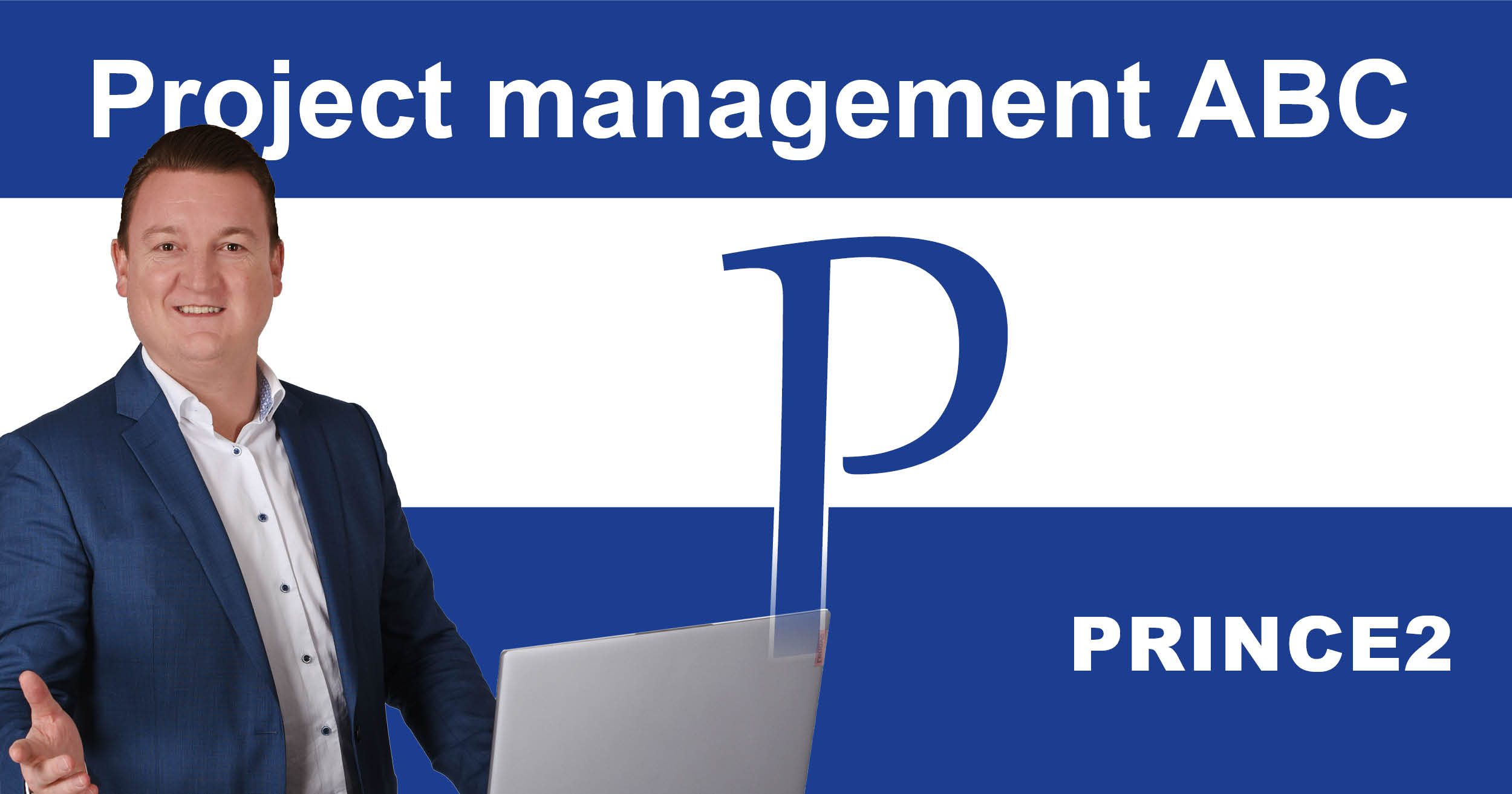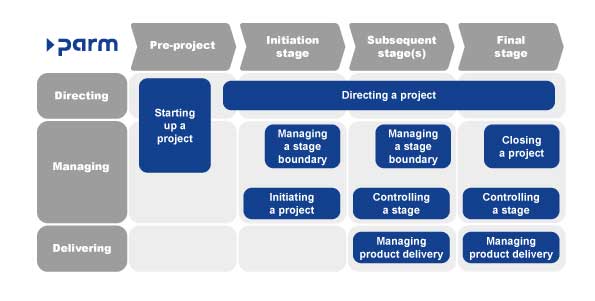Project management ABC: P for PRINCE2
Project success with the PRINCE2-method

No matter the size, scope, or nature of a project, every project comes with challenges. However, with the right project management method, these challenges can be tackled effectively. PRINCE2 is one such method that is used in over 150 countries worldwide in a wide range of industries and sectors, making it one of the most widely practiced project management methods in the world. It provides a structural framework that focuses on organization and control throughout the project. We explain the basics of the method.
What is PRINCE2?
PRINCE2, which stands for “PRojects IN Controlled Environments”, is an internationally recognized method for project management. Developed by the UK government, PRINCE2 provides a structured approach to the planning, implementation, and monitoring of projects of any size and complexity.
The method is based on seven fundamental principles designed to ensure that projects are carried out effectively and efficiently. In addition, PRINCE2 also defines seven processes that are followed throughout the project lifecycle. Each of these processes has clear objectives, activities, and outcomes to ensure that the project stays on track and achieves the desired results.
In addition to the principles and processes, PRINCE2 identifies seven practices that must be considered in every project, ensuring that all important aspects of the project are considered and managed to ensure project success.
The seven principles of PRINCE2
PRINCE2 is based on seven basic principles that must not be changed if a project is to be implemented using this method. However, these principles are formulated in such general terms that they can be applied to any project and any company. A project can only be managed by PRINCE2 if all of these basic principles are adhered to.
1. Continued business justification:
Every project must have a clear reason for its implementation, a necessity, and a sustainable benefit for the customer. At the same time, it is only justified if it continuously meets the needs of the company. This means that throughout the project, it must be regularly checked whether the project still meets the business requirements and objectives. If these changes or the project is no longer justified, it should be adapted or discontinued completely.
2. Learn from experience:
This principle emphasizes the importance of continuous improvement by learning from past experiences. Project teams should document, analyze, and apply their experiences to future projects to avoid repeating mistakes and use best practices.
3. Defined roles and responsibilities:
All roles and responsibilities of a project must be clearly defined and communicated before the project starts. In this way, each team member knows exactly what their tasks are and what responsibilities they have to enable effective collaboration and decision-making. At the same time, the interests of the various stakeholders can be represented.
4. Manage by Stages:
Every PRINCE2 project is divided into phases that are planned, monitored, and managed separately. This makes it possible to identify and solve problems at an early stage and maintain control of the project.
5. Manage by exception:
Tolerances are defined for each project objective. These in turn determine the scope of action for authorizations. This enables project teams to work efficiently and make decisions even in the event of minor deviations. However, if the tolerance limits are exceeded or the deviations are too large, an escalation or decision by the stakeholders is necessary.
6. Focus on Products:
PRINCE2 projects are geared towards the definition and delivery of products, with a focus on their quality requirements. This ensures that the project creates clear added value for the company and delivers the desired results.
7. Tailor to suit the Project Environment:
Every project has specific requirements in terms of its environment, scope, complexity, importance, performance or risk. It is therefore important to tailor the method to the particular company or project to achieve the best possible results.
The seven Practices of PRINCE2
The seven practices of PRINCE2, formerly known as the seven themes, are important aspects of project management that need to be continually addressed during the execution of each project to ensure that the project is carried out effectively:
- Business Case: The business case is the rationale for the project and sets out the business reasons for undertaking the project. It describes the expected benefits, costs, risks, and return on investment (ROI) of the project. The business case is monitored and updated throughout the project lifecycle to ensure that the project continues to be justified.
- Organization: The organization describes the structure of the project team and the roles and responsibilities of the team members. It also includes the relationships between the project team and the relevant stakeholders.
- Quality: The topic of quality is concerned with ensuring that the products or results of the project meet the agreed quality standards. It includes defining quality criteria, monitoring product quality during the project, and ensuring that quality standards are met.
- Plans: The plans describe how the project is to be carried out, including schedules, resources, costs, and risks. There are different types of plans in PRINCE2, such as the project plan, the phase plans, the product delivery plan, or the communication plan. These plans provide a roadmap for the project and help to monitor progress and keep the project on track.
- Risks: The topic of risks deals with the identification, assessment, treatment, and monitoring of risks in the project. Risks can be potential obstacles or problems that could jeopardize the success of the project. The effective management of risks helps to identify and resolve problems at an early stage and keep the project on track.
- Changes: This topic deals with the management of changes to the project, including changes to scope, requirements, schedule, or budget. Changes must be carefully assessed, approved, and documented to ensure that they do not compromise the project objectives.
- Progress: Progress is concerned with monitoring and measuring the progress of the project against the planned schedule, budget, and scope. Regular status reports and reviews are carried out to ensure that the project remains on track and that any deviations can be identified and corrected in good time. This aspect also describes the decision-making process for the acceptance of plans and the escalation process if the project does not go according to plan.
The main processes of PRINCE2
The main processes of PRINCE2 divide the entire life cycle of a project into clearly defined steps and phases and thus simplify the management of the project:

1. Starting Up a Project – SU:
In this process, it is first determined whether the project is feasible before it is designed and initiated. The objectives, scope, risks, and organization of the project are defined. The client receives the project mandate and a project manager is appointed. The project management team is also determined. At the end of the initiation process, the project mandate is drawn up, which forms the basis for the further planning and implementation of the project. The reasons for the project, its scope, and solution approach are documented in a project description. The initiation phase is also planned.
2. Directing a Project – DP:
This process involves the monitoring and steering of the project at the highest level by the project board, or steering committee. The project board receives regular status reports and decides on changes to the project to ensure that the project meets the company’s objectives and remains within the agreed tolerances. In this process, the initiation of the project is approved, but also the project completion. This process is therefore part of all project phases.
3. Initiating a Project – IP:
Detailed plans for the project are drawn up in this process. The business case, project objectives, resources, risks, and quality are further specified. A detailed project plan is developed, which forms the basis for monitoring and controlling the project. The project manager is officially appointed and their role and responsibilities are clearly defined.
4. Controlling a Stage – CS:
This process is concerned with monitoring and controlling the work within each project phase or “stage”. The project manager monitors the progress of the work, identifies and resolves problems, reviews the quality of the work, and updates the project plan as necessary. The project board receives regular status reports and decides on changes to the project. This process therefore describes the day-to-day management by the project manager.
5. Managing Product Delivery – MP:
This process deals with the delivery of the products or deliverables of the project. The work is managed by the team managers who are responsible for the delivery of the agreed products. The project manager monitors progress, solves problems, and ensures that the products meet the agreed quality standards.
6. Managing a Stage Boundary – SB:
This process marks the end of one project phase and the transition to the next. The project manager prepares an end-of-phase report summarizing the status of the phase and an updated project plan for the next phase. The project board reviews the report and approves the progress of the project.
7. Closing a Project – CP:
In this process, the project is formally closed. The project objectives are reviewed, the final products are handed over and the final reports are prepared. A lessons learned report documents the experiences and findings from the project, which can be useful for future projects. The project contract is formally closed and the project team disbanded.
Is PRINCE2 agile?
PRINCE2 is a very flexible method that strongly emphasizes adaptation to the respective project environment. However, PRINCE2 is part of traditional project management. To support organizations in carrying out projects in complex, rapidly changing environments, PRINCE2 Agile was developed as an extension of the method that supplements the PRINCE2 principles with agile approaches.
Essentially, PRINCE2 Agile complements the principles, practices, and processes of PRINCE2 with agile approaches such as Scrum, Kanban or Lean Startup. This allows project teams to maintain the structure of PRINCE2 while applying agile practices such as incremental delivery, regular feedback, and continuous improvement. PRINCE2 Agile therefore describes how and where the original method can be adapted to optimally combine it with agile approaches. For example, the CYNEFIN approach is used to determine the degree of complexity and uncertainty of a project, or the dimensions of project management (time, costs, quality, risks, scope, benefits) are made flexible with HEXAGON.
Conclusion
PRINCE2 is particularly suitable for projects that require a clear structure, governance, and control. As the method is very flexible, it can be adapted to a wide range of projects and organizations and is therefore well suited to large and complex projects, projects with defined deliverables, projects with external stakeholders, projects with long lifecycles, projects in regulated industries or projects with high levels of uncertainty. With its clear structure, defined roles and responsibilities, and emphasis on continuous improvement, PRINCE2 offers a proven and popular method for successfully delivering projects.
myPARM ProjectManagement can be a valuable addition to the application of PRINCE2. The comprehensive project management software has been specially adapted to support PRINCE2 projects.
With functions such as project planning, resource management, risk management, change management and progress monitoring, myPARM ProjectManagement provides a robust platform for the implementation of PRINCE2 projects. In addition, the software offers functions for team collaboration and communication, integration with other company systems and the ability to adapt to the specific requirements of each project. By using myPARM ProjectManagement, organizations can effectively plan, execute, and monitor their PRINCE2 projects and maximize project success.
Learn more about the project and portfolio management software myPARM:
Would you like to get to know myPARM in a demo presentation? Then make an appointment with us right away!
